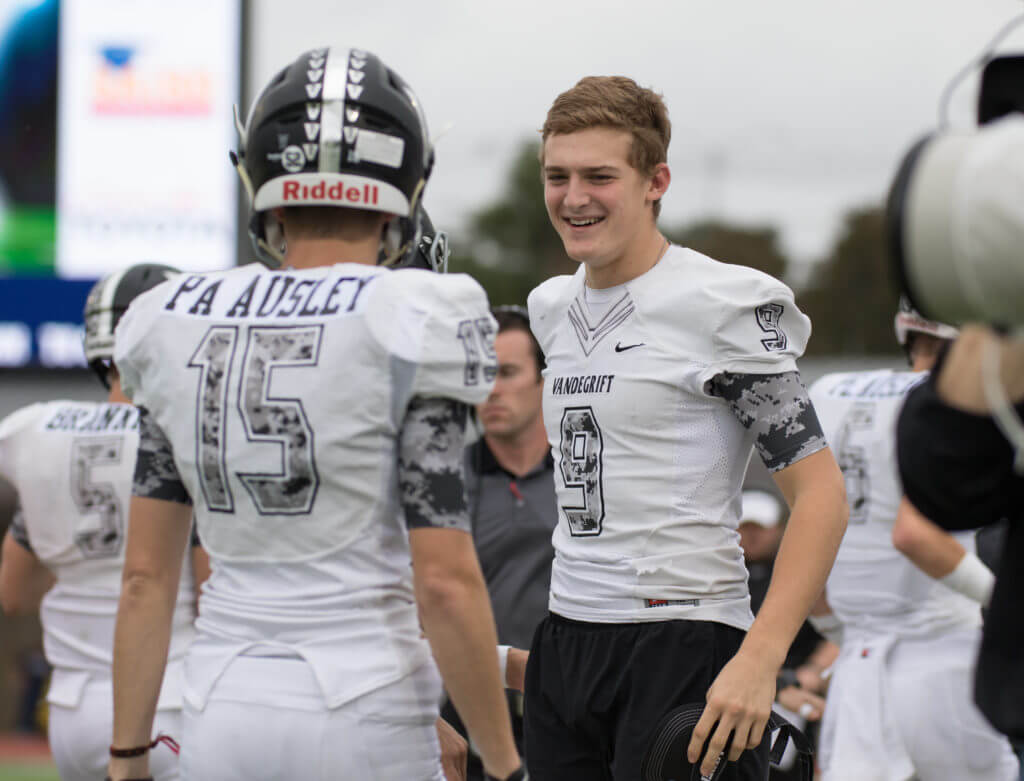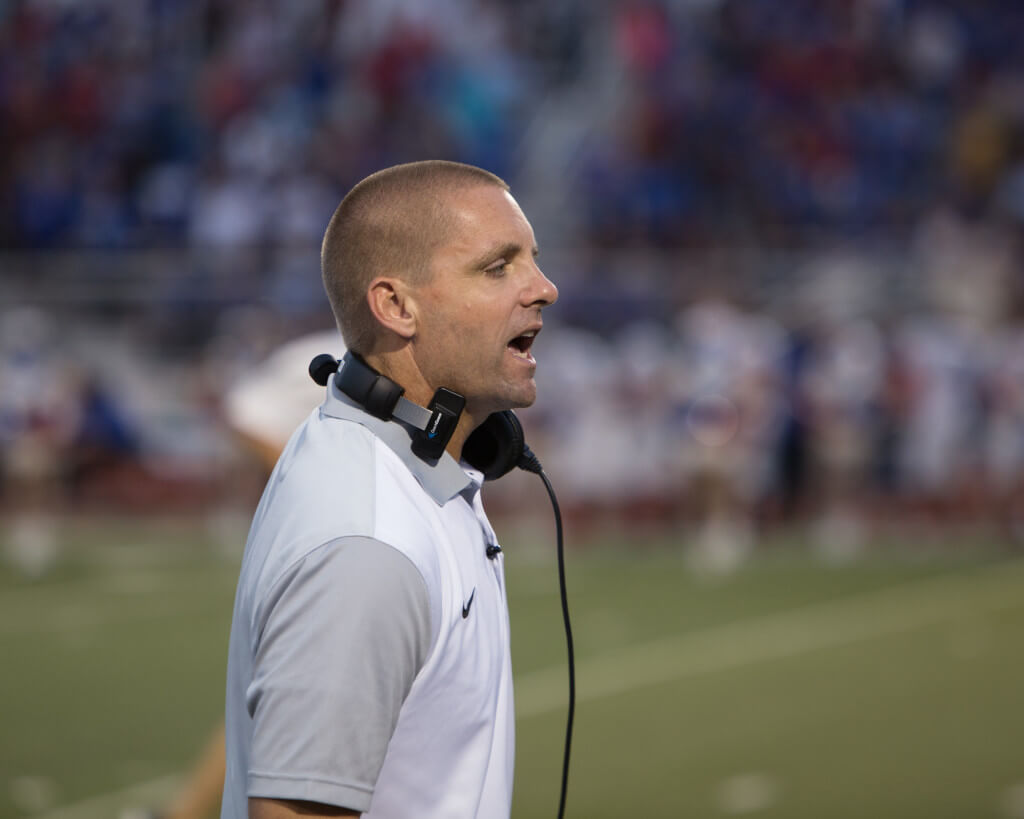
Vandegrift Vipers senior wide receiver Paxton Segina (9) congratulates his teammates during the Class 5A, Division I regional semifinal playoff game at Alamo Stadium in San Antonio on Friday, November 27, 2015.
Because of Vandegrift and Leander ISD concussion protocol, Segina was on the sidelines, unable to play at the game against East View, several games after he was airlifted from a home game where he encountered a concussion after a hit. “As a staff, we are so thrilled to see Paxton make a full recovery and further his football career at Stanford University,” said Drew Sanders, VHS athletic director and head football coach. Photo by Scott W. Coleman
Published May 4, 2016
By SARAH DOOLITTLE, Four Points News
Concussion management at Vandegrift has increased over the past several years, and it seems to be helping. Concussion numbers have gone up only slightly even though the VHS student population has increased, and concussions have gone down specifically in football, said Drew Sanders, VHS athletic director and head football coach.
During the last school year, 2014-15, the football team experienced three diagnosed concussions in practices, five in games and two that happened to players in their daily lives. There were twice as many concussions the previous year, Sanders said.
School-wide and in all sports during the same period, concussions at Vandegrift increased slightly, “the numbers rose barely but a reminder, school population did increase,” he said.
Even though all sports including soccer, lacrosse, basketball and volleyball have concussion risks, this report focuses on football.
“My job is to make this sport the safest I can possibly make it… I try to limit as much risk as I can. That’s my job,” said Sanders, who has been coaching for 20 years, the past eight at VHS.

“Football is safer than it’s ever been to play. When I played football, concussions weren’t even talked about,” said Drew Sanders, VHS athletic director and head football coach. He thinks the national conversation currently taking place around football and concussions is a good thing.
Photo by Scott W. Coleman
After all, he added, “we’re playing a sport where we are told to run into somebody. (Every other sport) you get a penalty if you run into somebody.”
Football’s come far
“Football is safer than it’s ever been to play. When I played football, concussions weren’t even talked about,” said Sanders.
He thinks the national conversation currently taking place around football and concussions is a good thing.
“I think it’s positive,” he said. In addition to the protocols in place for coaches these days, “now you’ve got other companies trying to find ways to keep our kids safer,” with better safety equipment and concussion measuring methods.
Sanders recognizes that concussions are challenging to measure and predict. “Not every hit is a concussion. It’s a really inexact science. Certain people don’t get concussions. And other people get them a lot.”
Keys to management
Sanders believes that relationships are the key to helping ensure safety. Without having a relationship of trust with their coaches, players cannot be depended on to communicate their injuries or concerns.
“Football is kind of a macho-type culture. It is guys that aren’t scared of contact. It’s guys that will go and dive and risk limbs to go catch a football, and don’t want to be perceived as weak. And so… our entire culture is built on relationships with our young men.”
The team is structured, too, to ensure that coaches are not involved once an injury has occurred.
“Once we (coaches) suspect,” a concussion or injury has occurred, “our job’s over… We are taught as coaches that if we suspect anything, our rule is, when in doubt, send him out. Which means he is going to the trainer, to the medical professional, and at that point we do whatever they tell us to do.”
Furthermore, the team only practices full-speed, contact to the ground tackling a maximum of around 40 minutes per week, which is well below the district limit of 90 minutes.
The school also has a concussion oversight team and a UIL-mandated return-to-play protocol. It’s a six-day protocol, day one of which does not start until a player is completely pain and symptom free, followed by a series of stages and testing overseen by Dr. Martin Molina, who works with VHS. Vandegrift cannot participate in UIL without following these guidelines.
As Sanders said, in the event of a player injury, “You want to make sure you did everything right by the rulebook to take care of him… I want to be able to look at our parents and say we took care of him as much as we can.”
Risk worth reward
Still, Sander takes no issue with the potential risks of football because he considers the benefits to far outweigh the risks.
“I would stand before you without a doubt and say that we’re going to keep our kids as safe as we can. We cannot eliminate all risk in a contact sport… I think the risk is worth the reward.”
After a lifetime of football, Sanders embodies a passion for the game and for the good it can do for those who play it.
The program is not just about football but also about character, community service and relationships, whether with friends, teammates or with parents, Sanders said.
“It is a unique sport that allows all shapes and sizes to contribute… What’s so special about football is that it allows even the most unskilled person to contribute and feel a part of something bigger than themselves,” he said.
He also thinks a quality football program can change the entire attitude of a student body.
“If I have 320 young men that are respectful of their teachers, that do what is asked of them, that give great effort in the classroom… and are taught how to give everything they have to what they are doing, that can change a school, I believe,” he said.
